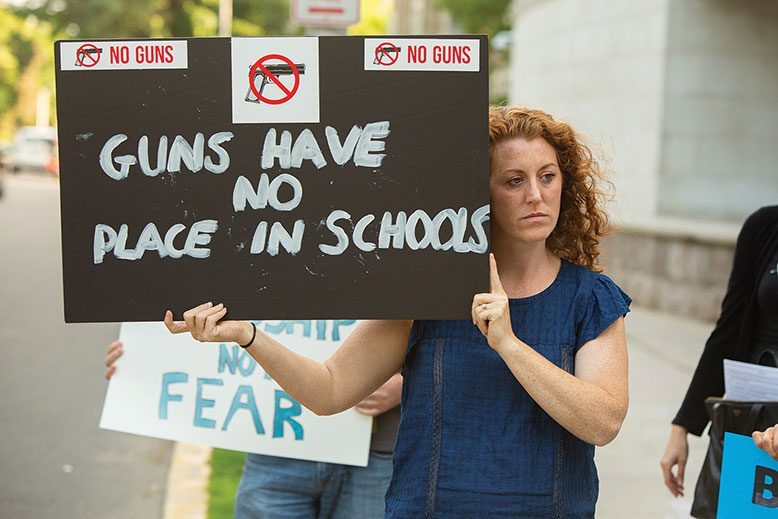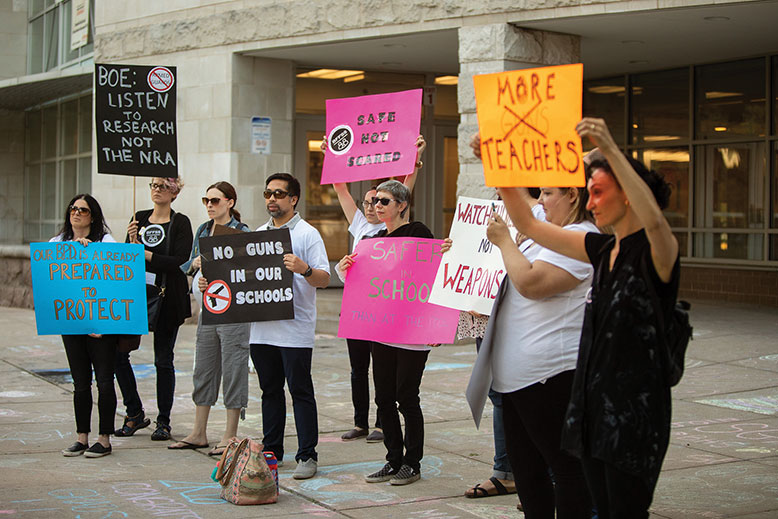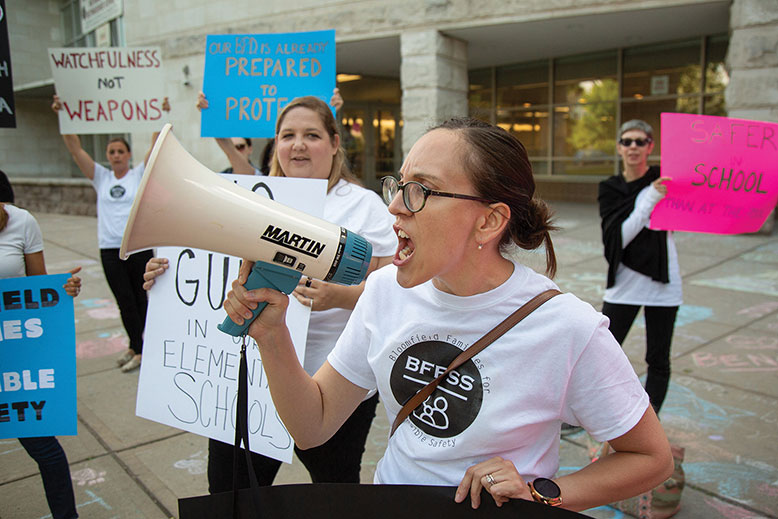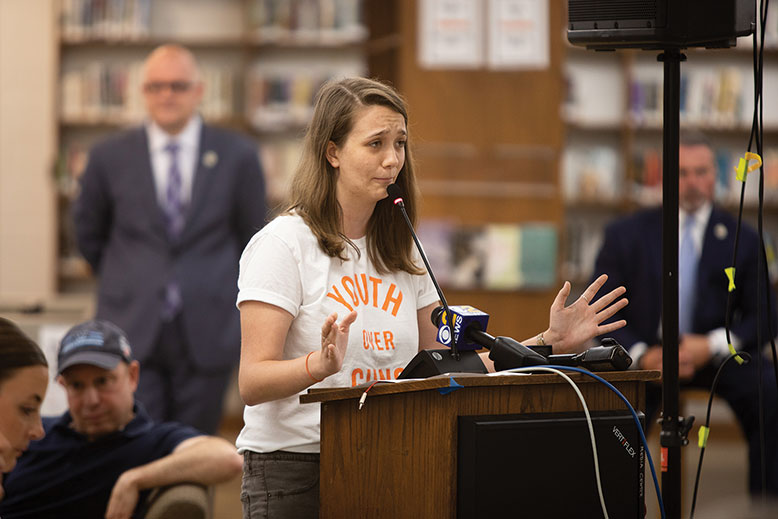
Like most Americans, East Brunswick Schools Superintendent Victor Valeski watched the death toll rise on television after the Parkland, Florida, school shooting this past Valentine’s Day. He couldn’t help thinking of his son, Chris, who by a stroke of good fortune had been spared in the deadliest school shooting in U.S. history, at Virginia Tech in 2007. Chris was to attend class that day in the building where a 23-year-old student fatally gunned down 27 students and five faculty members. Only a heads-up phone call from a friend about an active shooter kept Chris out of harm’s way.
Valeski and the township police chief had been talking about adding armed officers at East Brunswick schools for more than two years. Now, as the horror of Marjory Stoneman Douglas High School in Florida played out, he decided it was time to take that step. The school board was scheduled to meet the next day. Valeski added an item to the agenda: school safety.
At the meeting, the board voted unanimously to spend $434,000 for an undisclosed number of armed police officers, who would be paid by the district for doing extra shifts. They would join 71 unarmed officers already in place. Valeski and the board had already invested millions of dollars in other safety measures, including cameras, photo identification of students and staff, background checking and new buzz-in locks on all doors. But for Valeski, it wasn’t enough.
The following day, an armed township police officer was posted at each of two schools. Three days later, cops with guns were patrolling all 11 township schools. In the blink of an eye, East Brunswick had decisively weighed in on a debate that continues to play out in school districts across the state.
Superintendents, school boards, teachers, parents and students in New Jersey, like their counterparts across the country, have been wrestling with school security since the Columbine High School massacre in Littleton, Colorado, in 1999, when two upperclassmen murdered 12 students and a teacher. Columbine sparked a fierce debate over how best to protect the nation’s schoolchildren.
Columbine presented a national conundrum with no easy answers. Gun control arguments were revisited with little result. Experts began scrutinizing school cliques and subcultures, bullying, mental health treatment, social media and video games.
Myriad strategies were offered, but the shootings continued. A predictable pattern emerged: After each shooting, an eruption of discourse has been promptly relegated to a drawer marked unresolved. The tenor of the debate reached a new level in 2012 after 20 young students and six adult staff members were gunned down in the Sandy Hook Elementary School in Newtown, Connecticut. The youngest victim was six years old.

Police lieutenant Marty O’Neill stands watch outside the Lawrence Brook Elementary School in East Brunswick as students arrive in the morning. An armed police officer works alongside unarmed security officers at the school. Photo by John O’Boyle
For many, Newtown was the tipping point. Demands escalated for stricter gun control. Gun advocates dug in their heels.
“The only thing that stops a bad guy with a gun is a good guy with a gun,” Wayne LaPierre, executive vice president of the National Rifle Association, opined shortly after the shooting. He called on Congress “to appropriate whatever is necessary to put armed police officers in every school in this nation.”
In February, after the Parkland shooting, President Donald Trump jumped on the LaPierre bandwagon, calling for the arming of teachers to increase school safety.
New Jersey’s largest teachers’ union flat-out rejected the notion of armed teachers, as did Governor Phil Murphy, and that matter seems closed in the Garden State. But the movement toward armed officers has gained traction.
After Sandy Hook, the state Department of Education and the New Jersey School Boards Association (NJSBA) endorsed the use of school resource officers (SROs) as a best practice, while deferring to local districts to decide on their use. Since then, the clamor for more armed officers in schools has increased with each mass shooting. Today, the issue is at the top of many school board agendas.
SROs have been around since the 1950s, but have increased in numbers dramatically since the Columbine shooting. SROs are sworn police officers who are supervised by local police departments, though their cost is often shared between the municipal budget and the school district. As of 2008, SROs had been assigned to more than 40 percent of the nation’s schools. But they are expensive; salaries and other costs usually surpass $100,000 per officer.
Acting on a proposal from the NJ Police Chiefs Association, in 2016 the NJSBA endorsed a bill that offered a cheaper option: tapping into the ranks of retired cops through the creation of a so-called class III officer as an alternative to an SRO. These officers would be under age 65, supervised by local police departments, and required to undergo specialized training. “We looked at the alternatives to the school resource officer,” a report from the NJSBA said. “We recognize it comes with a big cost factor. State funding is stagnant. We don’t have leeway to keep increasing property taxes.” (A third, more expensive alternative for schools is the use of private, armed security personnel.)
The bill creating the class III officer option was enacted in January 2018—just six weeks before the Parkland, Florida, shooting, where a 19-year-old former student with an AR-15-style rifle killed 14 students and three staff members.
The aftermath of this shooting was different. Surviving Parkland students organized and spoke out like never before. Their message resonated with students across the country, and a wave of youthful protest followed. A flurry of copycat threats and false alarms further worried New Jersey school officials. East Brunswick’s swift reaction attracted considerable media attention. Soon other schools followed suit.
Since the class III officer law was passed, at least 55 such officers have undergone the specialized training and an estimated 67 more have registered for future sessions, according to Patrick Kissane, chief of police in Fort Lee and executive director of the New Jersey Association of School Resource Officers, a nonprofit that provides training for all SROs and class III officers.
Kissane says that properly trained school officers become part of the school community and can address numerous challenges, including suicide prevention, gang activity, bullying and drugs. They can also serve as mentors and as resources for students, parents and staff. He points out that a class III officer in Montvale saved a student from choking to death earlier this year. “You need the right type of police officer and the right type of policing,” he says.
While Valeski did receive some social media criticism for his rapid deployment, it was nothing compared to what subsequently erupted in Bloomfield.
Salvatore Goncalves was named schools superintendent for the Essex County township five years ago—around the time Sandy Hook was driving the national debate. He had become particularly concerned with the level of security in the elementary school entry vestibules. There were armed SROs and private-security personnel in the high school and middle school, but none in the elementary schools.
Among other steps, the district installed buzz-in locks and cameras and looked into various construction options. The latter, Goncalves says, proved impractical or prohibitively expensive in the aging buildings, which range from 60-100 years old. Then came the class III officer legislation, which “provided us an affordable option,” he says. The Parkland shooting “kicked it into gear.”
But Goncalves and the board did little to bring parents into the decision-making process. It wasn’t until after the school budget was presented in April that the public learned that $550,000 had been set aside to hire nine class III officers for the elementary schools. The budget and the security measure passed that night. An uproar ensued.
“I was floored,” says Jean Beeks, a former Brooklyn resident and teacher, who had just closed on a house in Bloomfield, where she and her husband planned to raise their young family. She, like many other mothers, learned about the decision on Facebook. “Had I known they were going to do this, I never would have moved here.”

East Brunswick schools superintendent Victor Valeski sought armed security for his district following the Parkland, Florida, school shooting. Photo by John O’Boyle
Beeks joined a growing opposition group, Bloomfield Families for Sensible Safety, comprised mostly of young mothers. The group’s petition garnered more than 265 signatures.
Bloomfield Families was initially “dismissed” by school leaders as a “small minority,” according to Melissa De Fino, a cofounder of the group. “We knew this couldn’t be true.”
The group reached out to the media, went door to door with flyers, and chatted up parents at school functions. And the mothers showed up by the scores at a school board meeting in June—addressing the board, one by one, to register their disapproval of the idea and the sense that they had been shut out of the process. They made well-researched statements—articulate and polite, yet firm.
Adding guns to the school environment only increases the odds of something going terribly wrong, they argued, while also pointing out the lack of credible studies supporting the effectiveness of armed officers in schools. A fraction of the money could be better spent on improving the architecture of the schools in a way that would improve security and hiring unarmed security personnel and guidance counselors, they argued.
But the idea of hiring armed officers for schools is a “no-brainer” for Bloomfield Police director Samuel DeMaio. The September 11 attacks “changed the way we travel,” he testified at the board meeting. “How many incidents do we have to have to change the way we secure our schools?”
“There is no evidence that armed guards will prevent or lessen the impact of a school shooting,” De Fino counters. “However, there is evidence that shows that the presence of a weapon, no matter who holds it, makes violence and accidents more likely to occur.”
De Fino’s views are shared by the national advocacy group Dignity in Schools, which launched a Counselors Not Cops campaign, first in 2013 after Sandy Hook, and again after Parkland. On its website, the group offers yet another reason why they believe armed officers are a bad idea.
The web statement reads: “The presence of police in schools has escalated dramatically in the last several decades, and the figures on arrests and referrals to law enforcement show disproportionate targeting of black and Latino students. This is just one aspect of the school-to-prison pipeline, where some students are denied an opportunity to succeed, and instead are pushed out of school and into the juvenile or criminal justice system.”
Tyler Gonsalves, who graduated from Bloomfield High School this year, agrees, noting that Bloomfield is one of the most diverse school districts in the state. The town is 46 percent Latino and black. Gonsalves, who is of Latin and Afro-Caribbean descent, says the sight of armed officers made her “uncomfortable” as a high school student. “I can’t imagine how that would make an elementary student feel,” she says.
Gonsalves contends that armed guards are more prevalent in diverse, urban districts. “I don’t think Bloomfield should be one of them,” she says. A founding member Students Demand Action in Bloomfield, Gonsalves has participated in walkouts and marches for gun control. “The solution,” she says, “is not more guns.”
The grassroots Bloomfield movement paid off. After meeting with members of the Bloomfield Families group, Goncalves and the school board decided to hold off on hiring the armed officers. Instead, the board scheduled a public meeting for late August. The mothers effectively stopped the plan in its tracks and gained a seat at the negotiating table. To further their cause, four members of Bloomfield Families plan to run for the school board in November.
Photos by John O’Boyle
Bordering Bloomfield to the west is the small, affluent town of Glen Ridge. There are no armed officers in the schools; the idea has yet to come up.
“We don’t believe armed officers are necessary at this time,” says school board chairwoman Elisabeth Ginsburg. “The schools and local police are in close physical proximity, with the police station literally across the street from two of our schools and within about one mile of the other two.” Response time, she says, is minimal.
Ginsburg, who is also executive director of the Garden State Coalition of Schools, a nonprofit advocacy group, also believes that state government needs to help with the considerable cost of school security as well as additional mental health services.
“School budgets have been severely constrained over the past eight years, and state aid has been extremely limited, forcing schools to make very tough choices,” she says. “No school district should be in a position where it has to choose between hiring critically needed teachers and upgrading security.”
New Jersey has some of the toughest gun laws in the nation, and thus far has been spared the trauma of a mass school shooting. In late 2016, New Jersey enacted legislation requiring all schools to conduct monthly security drills. Twice-yearly active-shooter and lockdown simulations are also mandatory.
At press time, two bills were awaiting the governor’s signature, one that would ask voters this November to approve the sale of $1 billion in bonds in part to improve school security, and another that would require public elementary and secondary schools to be equipped with panic alarms for school security emergencies. The latter bill is called Alyssa’s Law in honor of Alyssa Alhadeff, a Woodcliff Lake teen who died in the Parkland shooting.
“When tragedies strike, we all seek to find answers and increase safety for our children,” says Ginsburg, adding, “there are no easy solutions.”
Correspondent Ian T. Shearn writes about politics and current affairs for New Jersey Monthly.



